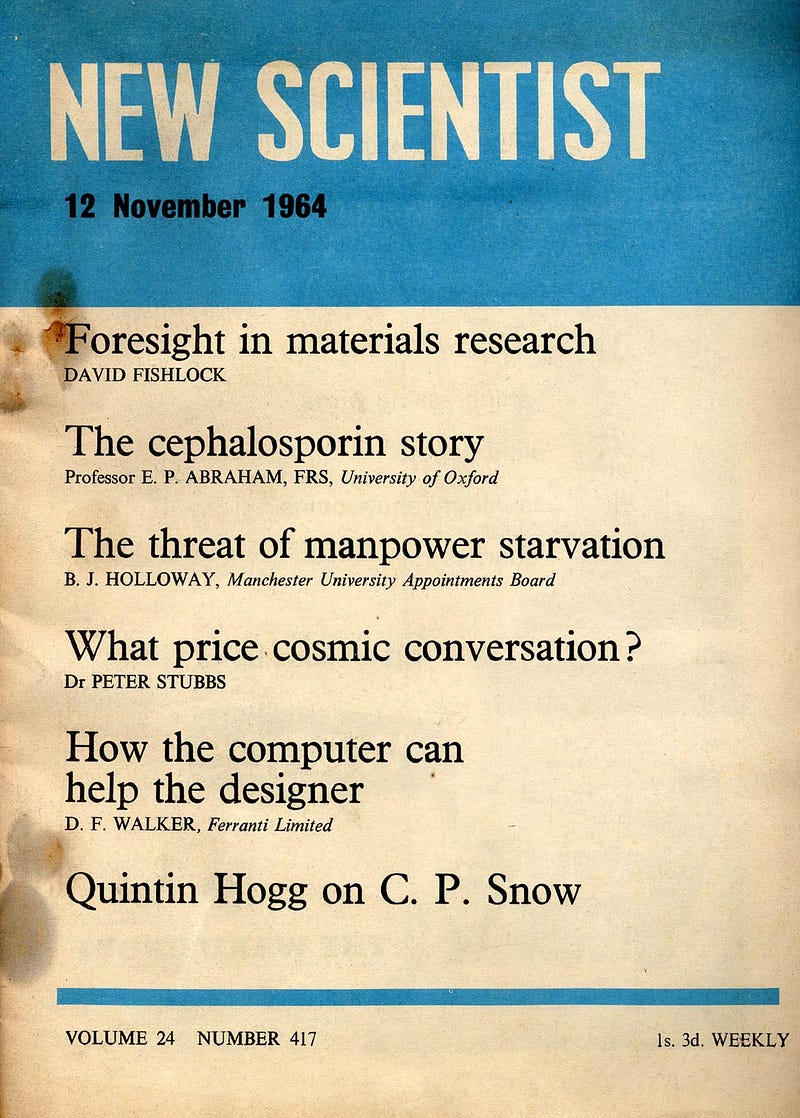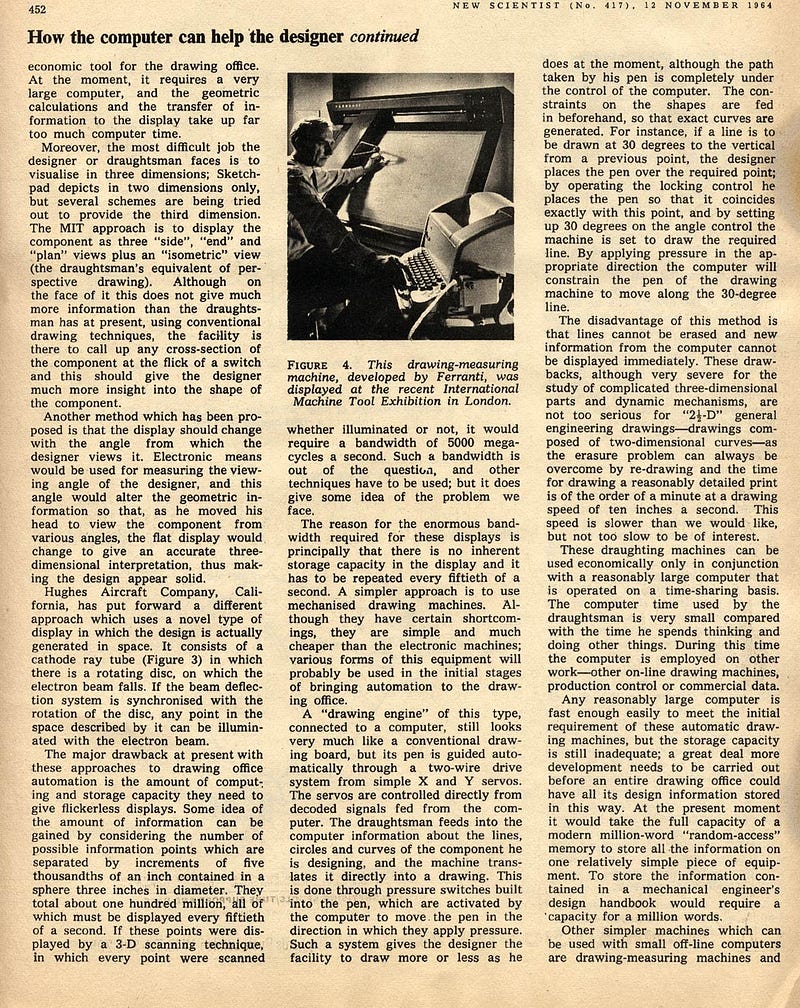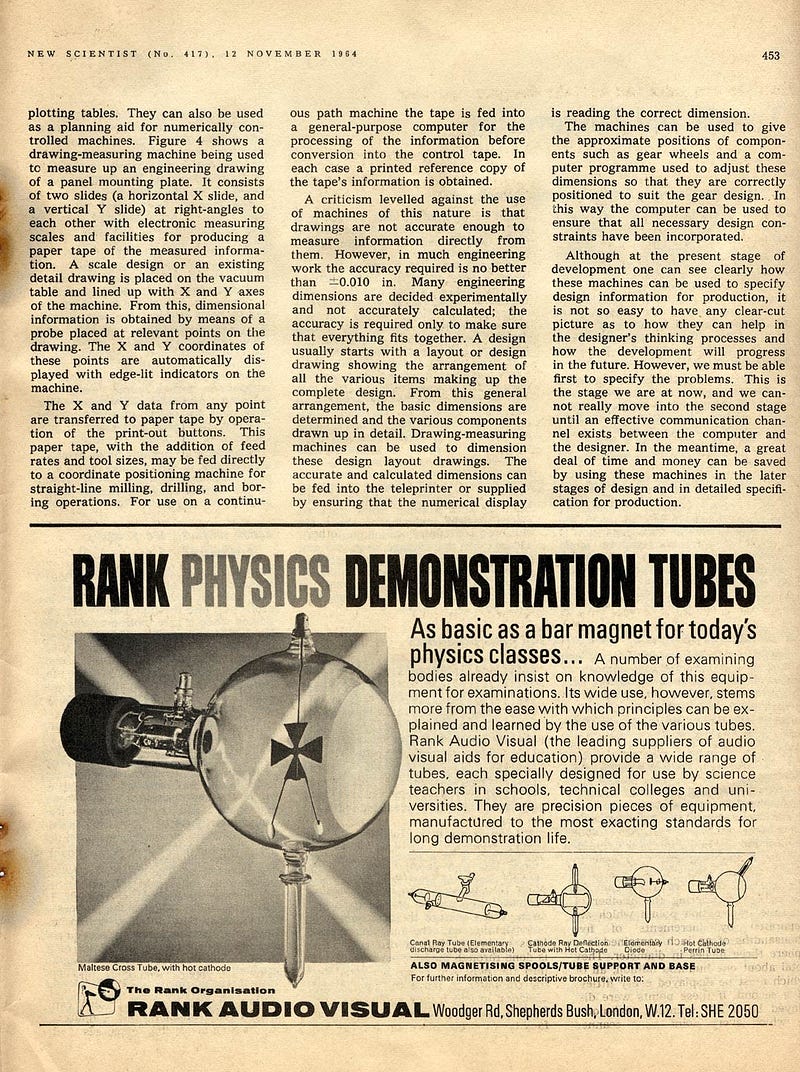
Interaction design for computer-aided design, 1964-style
Like most designers, I have bundles of old magazines littering the place up: ’50s Life; ’60s Punch; copies of the The Face, The Wire and iD from the early ’80s, some Emigres from the ’90s, etc and so on. Leafing through a copy of New Scientist from 1964, so old that the staples had corroded and vanished leaving only ferrous brown smears, I chanced upon the following article. (Ed. This piece originally published at cityofsound.com on 1st February 2006.)
Written by D. F. Walker of Ferranti Limited, “How the computer can help the designer” was surrounded by other pieces asking “What price cosmic conversation?” or taking us through “The cephalosporin story”, and further surrounded by the glorious period context of the adverts.

These give a sense of a British manufacturing industry still in full bloom, the sheer technical power of an empire still present at background trace levels, such as in the central London addresses for companies now long gone, an Ealing Comedy-like tone pervading the mental images. But between the lines, or rather between the classifieds, it’s also possible to detect change afoot e.g. several adverts indicating increased scientific emigration to Australia (perhaps Britain’s human supply chain there describes a vanishing point of empire — from transportation society to information society in 100 years).
Other adverts can now be re-contextualised as inadvertent pop-poetry: “People who shape society ready New Society” or “At Halewood, building 2 Corsairs every minute … FORD KEEP ON SCHEDULE WITH COVENTRY CLIMAX FORK LIFT TRUCKS. Telephone Coventry 28481”.
However, nostalgia ain’t what it used to be. Of genuine interest 40 years later remains Walker’s article. I’ve scanned the whole thing in for you to read below.




It’s a fascinating, sometimes unpredictable read. On one hand, there’s no real sense of what a computer might be for a designer; on the other, some of the statements and suggestions concern developments we’re still working towards.
Leaving aside the anachronistic elements (large computers, operated by men, deployed mainly in industrial machine control context) much of the article is revealing. There’s little sense of the eventual ubiquity of computers in design practice, or to the range of tasks that we expect them to perform. However, Walker notes that it’s natural that computers should impact design, given the development thus far (emerging from clerical and scientific arena; from arithmetic to logical decision-taking) and he does state that “almost unlimited scope exists for computers in the drawing office”. I wonder how that statement was received at the time?
That scope described here seems relatively limited, at first. But perhaps we should remember how design itself has diversified — and I don’t just mean in the Herbert Simon “everyone designs” sense, as that was always true — but as professional practice. At this point, graphic design was still arguably hatching from the shell of ‘commercial art’, for instance, and design as a trade seemed most closely allied to engineering. Perhaps this is New Scientist showing its roots, but just as the scope of the computer in design seems attenuated here, so does the implied scope of design itself. However, we still can find a vivid description of the computer’s possibilities in Walker’s words.
Three-dimensional visualisation is “the most difficult job the designer or draughtsman faces”, and hence much of the article focuses on possibilities here. The likes of SketchUp aside, it’s an area which is still a relatively advanced skill for designers. Is that to do with the development of software, hardware or industry? It was clearly a priority here, but perhaps this is the difference between the designer as Walker has it — close to engineering, where CAD/CAM has made significant inroads — and the designer as we see it now.
I found the reflections on time interesting. Computers of that era often worked on a time-sharing basis, the operator’s calculations jostling against many others for the attention of the beleaguered processors. This mean you submitted your instructions … and waited. I’m almost feeling a longing for this kind of therapeutic reflection — what the article describes as “thinking time versus computer time” — given how our raw thinking is often articulated through computers (as I write, I’m writing in atoms, thinking on the screen, recombining and editing in real time).
Of course, the articulation via the contemporary computer is also an extension of capability, arguably. But I’m somewhat in favour of this ‘slow design’ even, in a fractal sense, at the level of the commands themselves. (I’ve long ‘campaigned’ against designers obsessing about Photoshop shortcuts, say. That chordal virtuosity becoming an end of its own. I’d rather designers took time to construct, possibly even with pen and paper first. Sometimes the journey is as important as the destination, as it describes thinking time, though don’t always try to swing that with clients.) In 1964 though, the computer’s time was something to take into account too, and perhaps lends the designer an enforced opportunity for reflection as a result.
Elsewhere, there is much talk of the rich possibilities in user interface. Again, our mouse/trackpad/keyboard/occasional tablet interfaces may seem a letdown to D. F. Walker, given the suggestions of haptic devices to provide a sense of input designers would be familiar with. The primary example is MIT’s now legendary Sketchpad, drawing directly on to the screen with a suggested fluidity that even today’s tablet PCs have struggled to sell to the public. Other devices Walker mentions track the designer’s line of sight to revolve 3D objects on screen. The basic act of drawing with a pen has a key role in all of this.
It’s this sense that the computers would be built around designers which seems to have got lost. We’re essentially using the same physical interfaces as all computer users — the software interfaces are radically different, but there’s a homogeneity of input device which appears incongruous given the heterogeneity of usage today.
As has often been commented on, though, there is little idea of the portable, networked nature of contemporary computers; Of the astonishingly fluid ubiquity of the PC, throughout design, throughout everything. We’ve frequently derided the infamous mid-century pronouncements of IBM and the like, but it’s still astonishing that the actual arc of development was and is so out of kilter with the projected arc. It should serve as yet another warning to those who predictions about technology and culture.
The challenges perceived in the article are interesting too. Storage remains a major concern: “A great deal more development needs to be carried out before an entire drawing office could have all its design information stored in this way” given that it would take a million “words” to store a “design handbook”. There’s little sense that that kind of storage would prove to be one of the easier problem to address. It’s as if the user interfaces and machine control were almost solvable in 1964, and that the things which would prove most inhibiting — almost beyond human comprehension — would be these near-mythical domains of storage, bandwidth, connectivity. Perhaps the reverse has occurred.
However, Walker’s last paragraph almost stands the test of time as is:
Although at the present stage of development one can clearly see how these machines can be used to specify design information for production, it is not so easy to have any clear-cut picture as to how they can help in the designer’s thinking processes and how the development will progress in the future. However, we must be able first to specify the problems. This is the stage we are at now, and we cannot really move into the second stage until an effective communication channel exists between the computer and the designer. In the meantime, a great deal of time and money can be saved by using these machines in the later stages of design and in detailed specification for production.
As much we continue to adore the rich interface of pen—paper—scratchy marks, I’d argue that designers have enjoyed great advances working with computers, which have become implicit within almost all professional design processes — perhaps the integral tool now. Walker himself seemed to have a sense that the range of possibilities engendered by computers was almost beyond comprehension, just as design as practice has blossomed beyond engineering. And yet I find that Walker’s words leave me pausing, considering just how much we have opened up “effective communication channels” between computer and designer, particularly given the research into user interfaces he describes here.
Did we specify the right problems in 1964? Are we even specifying the right ones now?
This piece originally published at cityofsound.com on 1st February 2006.

Leave a comment